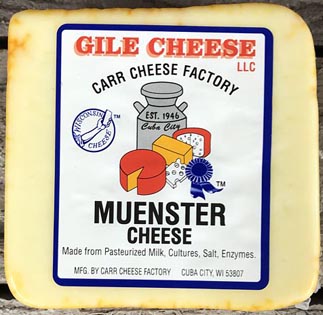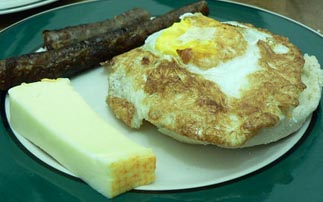Muenster cheese
Muenster cheese is a semi-firm American variation inspired by French Munster cheese. This version of washed rind cheese is crafted using pasteurized cow’s milk.
Typically, the American muenster boasts a smooth, pale-yellow interior and a fairly soft texture with a thin, orange rind. Unlike its French counterpart, American Muenster is aged for a shorter period, resulting in a milder flavor profile.
 |
In the earlier times, it was made by the monks at Munster Abbey in the modern-day Alsace. French and German immigrants to the United States began making muenster cheese in Wisconsin in the late 18th century.
American muenster cheese production:
Add the bacterial (mesophilic) culture to pasteurized cow's milk in the vat at 29° C to curdle (acidify) the milk, stir gently, cover, and set aside to ripen for 15 minutes.
Add annatto colorant, if desired.
Next, add curdling enzymes (liquid rennet) to coagulate the milk. Stir gently but thoroughly. Cover the pot and let the curd mixture sit at this temperature for 45 minutes.
Cutting the curd into 1 cm pieces, resulting in a larger surface area to aid ease the whey separation.
Gently raise the temperature of the curds to 38° C, at a rate of 1° C every five minutes. This will take 25 minutes. Stir occasionally and gently with a ladle while heating to keep curds from matting.
Maintain at this temperature for 30 minutes, stirring gently every few minutes.
Molding of muenster: Once the whey has drained, the curd particles are transferred into molds lightly compressed, and left for 1 hour to fuse and take on the shape of the mold. Store the molded curd at 16 - 18° C.
Let curds settle for 5 minutes, drain off the whey from the curds, and place a second mat on top of the curds to make a “sandwich”.
Drain for 30 minutes; then, holding the sandwich tight, quickly flip and place back down.
Remove the top mat, rinse, and return to cheese. Repeat the step above five more times, every 20 minutes. Let cheese rest for 12 hours (overnight) at room temperature on mat.
Remove cheese from hoop and float in saturated brine for 12 hours at 10-12° C. Turn every 2 hours to ensure even rind development.
Then, Remove cheese, pat dry, and place on a clean mat.
Cheese ripening is in two phases. in the first phase, ripen at 16° C and 90-95% humidity for 1-2 weeks. Wipe down cheese every second day with a clean cloth and brine solution, this will encourage the uniform distribution of the mold.
In the next phase ripening, either seal the cheese with wax or vacuum bag and age for another 4-10 weeks minimum at 10° C and 90-95% humidity and allow rind to dry. Wipe the cheese every 3rd day with a brine-soaked cloth or with sweetish German white wine.
Usually, aged muenster is placed in retail containers along with a brine solution, sealed, and stored under refrigerated conditions.
Muenster cheese Health benefits
Muenster cheese is a high-calorie dairy product; 3.5 oz (100 g) contains 368 calories and 30 g of fat. Nonetheless, it is one of the finest sources of several nutrients, including protein and vitamin D.
Muenster provides high-quality protein that is rich in all essential amino acids needed for growth, development, and overall health. 100 g of Muenster contains 23.4 g, or about 42% of the recommended daily intake of protein.
Aged Muenster contains a small amount of lactose, making it one of the low-lactose dietary sources of calcium for those with lactose intolerance.
Muenster, being a dairy product, is free from gluten. For gluten-sensitive individuals (Celiac disease), it is another important source of gluten-free food rich in protein, minerals, and vitamins.
During the ripening process, remnants of lactose and other major milk constituents such as milk lipids and milk proteins undergo biochemical changes into more easily digestible and health-benefiting products.
American Muenster is one of the finest sources of dietary calcium and phosphorus in the diet, and together with vitamin D, it plays an important role in bone strengthening and growth, especially in children.
Muenster is a very good source of fat-soluble vitamins, especially vitamin A. 100 g of ripened Muenster contains 1010 IU (33% of RDI) of this vitamin.
Muenster cheese is a dense source of essential minerals, especially calcium (717 mg, 72% of RDI), phosphorus (468 mg, 67% of RDI), zinc (28.5% of RDI), and selenium (26% of DV).
| Principle | Nutrient Value | Percent of RDA |
|---|---|---|
| Energy | 368 Kcal | 18.4% |
| Carbohydrates | 1.17 g | 1% |
| Protein | 23.4 g | 42% |
| Total Fat | 30 g | 150% |
| Saturated fats | 19.1 g | 191% |
| Cholesterol | 96 g | 32% |
| Dietary Fiber | 0 g | 0% |
| Vitamins | ||
| Folates | 12 μg | 3% |
| Niacin | 0.103 mg | 0.65% |
| Pyridoxine | 0.056 mg | 4% |
| Riboflavin | 0.32 mg | 2.5% |
| Thiamin | 0.013 mg | 1% |
| Vitamin-A | 1010 IU | 33% |
| Vitamin-C | 0 mg | 0% |
| Vitamin-D | 22 IU | 4% |
| Vitamin-E-α | 0.26 mg | 1.5% |
| Vitamin K | 2.5 µg | 2.2% |
| Electrolytes | ||
| Sodium | 628 mg | 42% |
| Potassium | 134 mg | 3% |
| Minerals | ||
| Calcium | 717 mg | 72% |
| Copper | 0.031 mg | 3.4% |
| Iron | 0.41 mg | 5% |
| Magnesium | 27 mg | 7% |
| Manganese | 0.008 mg | <1% |
| Phosphorus | 468 mg | 67% |
| Selenium | 14.5 mg | 26% |
| Zinc | 2.81 mg | 25.5% |
Culinary Variations of Muenster Cheese
There are three main variations of the Munster cheese- French, German, and American. The French version is considered the best quality among the Muenster, especially the farmhouse produce, which has a superior flavor and smell than the industrial variant.
The cheese produced by the farmhouse is given the Appellation d'Origine Contrôlée (AOC) Certification. Munster-Géromé a French version of Muenster has anise seeds in the cheese.
Buying
Muenster cheese is readily available at many grocery stores all across the U.S. It is pale yellow with orange rind, washed rind cheese. Classical French Munster has a strongly aromatic and tangy taste.
While buying, look for the nomenclature- the name of the food is 'muenster cheese', and the label declaration - reading production date, packing, and "use by" date.
The US-FDA recommends that Muenster cheese should have 48.0% moisture by weight and 50.0% fat by weight of the solids.
Storing
Similarly to other soft cheeses, Muenster cheese also has a high moisture content and should be refrigerated to prolong its shelf-life, ideally at 35-40°F in a refrigerator drawer. Once opened, wrap it in wax or parchment paper, then cover it with plastic wrap before returning it to the refrigerator.
An opened block of Muenster can last for 3 to 4 weeks when stored properly in the refrigerator.
If mold develops on a block of Muenster, it's advised to cut away at least 1 inch around the affected area, then re-wrap and store the cheese appropriately.
If mold appears in a package of shredded or sliced cheese, it's best to discard the affected portion.
Food uses
Muenster is a kind of washed rind cheese, usually eaten as a table cheese with wine and fruits. Since Muenster cheese has a characteristically low melting point, in a way similar to Colby and Monterey Jack, it is preferred in grilling and in snacks and salads.
Here are some serving tips:
 |
| Muenster cheese. Courtesy: stu_spivack |
Enjoy muenster cheese as a snack or as an appetizer before dinner with beer or wine.
Muenster melts easily in the recipes. It is used in grilled dishes such as sandwiches cheeseburgers, and pizza toppings.
It is the best-suited cheese in the classic mac (macaroni) and cheese recipe.
Safety profile
Muenster cheese is known for its high content of saturated fats, cholesterol, and salt, making it a rich but potentially unhealthy dairy option.
An excessive intake of sodium can lead to water retention and elevated blood pressure.
With approximately 19.1g of saturated fats and 96 mg of cholesterol per 3.5 oz serving (32% of the Daily Value), Muenster cheese ranks among the top sources of saturated fats and cholesterol. Saturated fats contribute to an increase in LDL (bad) cholesterol levels, thereby raising the risk of heart disease and stroke.
For individuals following a diet plan, low-fat or fat-free varieties of processed cheese may be a preferable option.
(Medical Disclaimer: The information and reference guides on this website are intended solely for the general information of the reader. It is not to be used to diagnose health problems or for treatment purposes. It is not a substitute for medical care provided by a licensed and qualified health professional. Please consult your health care provider for any advice on medications.)
Also read ≻≻-
≻≻- Cheddar cheese nutrition facts.
≻≻- Cottage cheese nutrition facts.
≻≻- American Cream cheese nutrition facts.
≻≻- Back to Dairy products from Muenster cheese nutrition facts.
≻≻- Back to Home page.
Further Resources:
USDA National Nutrient Database. (opens in new window).
21 CFR - Muenster and Munster cheese Cornell Law School. (opens in new window).
Cheeseforum.org. (opens in new window).